14 Gourmet Food Cooking Techniques To Show Off Your Culinary Skills
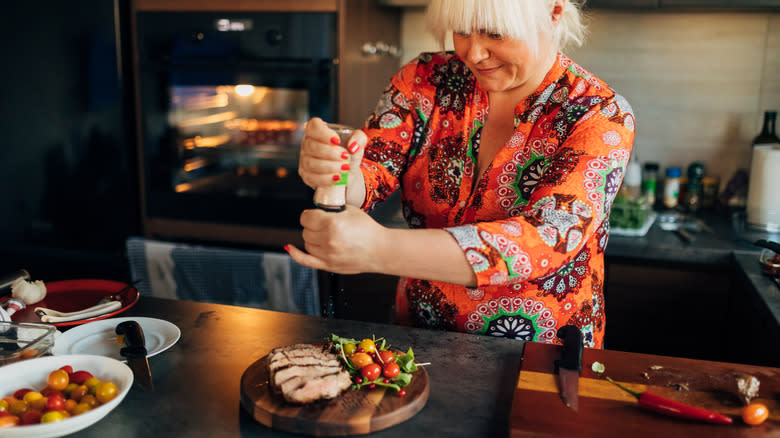
Dining out at sophisticated eateries broadens your foodie horizons. And with this, there's often a quest to set off on at-home culinary adventures too. While simple potluck recipes have their place, so too does the wonderful world of dinner party molecular gastronomy. If you're not quite sure what this is, it's basically using a scientific approach to transform dishes into marvelous savory or sweet masterpieces. These methods can change the taste, texture, and purpose of ingredients enough to impress the most experienced luxury diner. Think smoking, frozen morsels, alcohol-induced flames, and jelly-like savory bubbles adorning sumptuous courses.
If you want to seriously up your game in the cooking department at home, then learn a few gourmet cooking techniques to show off your culinary skills. While not all of them are challenging or require specialist equipment, some of them do, and safety guidelines need to be followed with several — but all are worth it.
Read more: The Most Useless Cooking Utensils, According To Chefs
Flambé
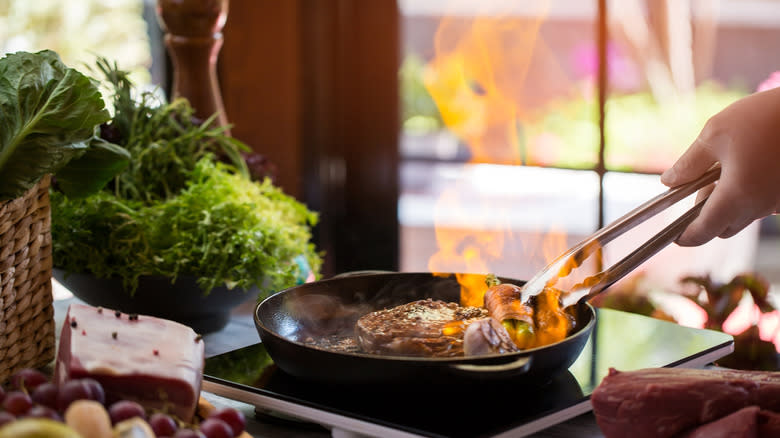
There are a lot of great tips on how to cook with alcohol, including how to flambé the safe way at home. There's something magical and impressive about flames leaping from a skillet and releasing incredible aromas. Make bananas Foster by pouring dark rum over the fruit that's browning in a pan with butter, sugar, and cinnamon. Set it alight with a long match and once it's extinguished let the syrup reduce before serving. While you can make Chateaubriand without any flambéing, it's traditional to add Cognac. Sear beef tenderloins in a pan of melted butter and seasonings, including sherry wine. Add the alcohol and you're ready to flambé.
Tableside flambéing is fun and dramatic with a tabletop stove. However, avoid walking from the kitchen to the dining table with a flaming pan. Choose alcohol that's between 80 proof and 120 proof, which will burn off in the right way. The key to success is to set the liquor alight quickly before it's got a chance to soak into the food. Take the sizzling pan off the heat to add the alcohol and use a skillet with high sides. Tilt it and put it back on the stove. If you're using a gas stovetop then the flames will ignite the pan. Shake the pan until the flambé flames have dissipated.
Flash Freezing
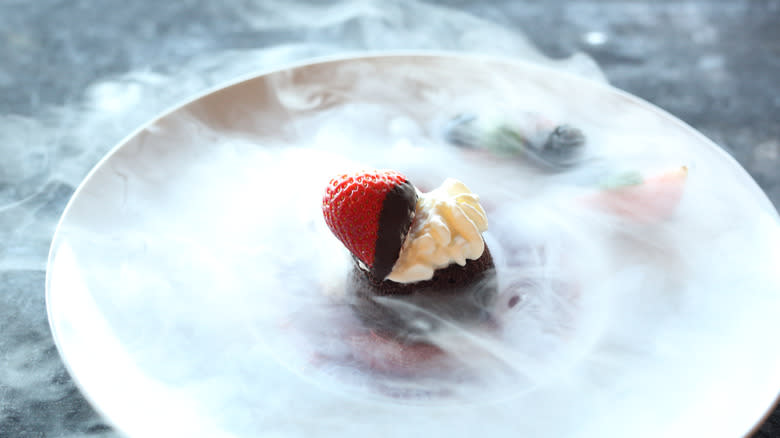
Using liquid nitrogen to flash-freeze has to be one of the most impressive gourmet food cooking techniques to show off your culinary skills. This molecular culinary process turns cooking into a lab-like process, and the results are instant and dramatic. It turns soft foods like strawberries into crunchy bites on contact. You can use liquid nitrogen to freeze the outside of food while keeping the center from hardening up. And let's face it, the swirling smoke that comes off of a bowl of it looks cool.
Safety is paramount. That means storing liquid nitrogen in a special vessel known as a dewar, wearing protective gloves and glasses, and ventilating areas when using it. Understanding the specifics of the risks can allow you, or your guests, to do this super-cool culinary performance at the table. However, you might prefer to leave this technique to the professionals and invest in an anti-griddle that freezes liquids on contact.
Clarification

If you've ever been to a fancy-schmany restaurant, then you may have had a clear consommé that's packed with powerful flavors. It might look like weak tea because the stock has been clarified, but the notes are rich and deep. It's a great gourmet food technique that creates delicate-looking dishes that taste incredible. You can serve consommé by itself, but you can also clarify a stock and use this for other dishes. After adding lots of ingredients to a pot with water and letting it bubble away, you need to take them all out. Strain with cheesecloth to start. Mix egg whites, with or without water, and add to the remaining stock. Heat, stirring in the egg, and leave for a few minutes off the heat before straining once again.
This is called an egg raft and it's a way of getting all the little bits out of the liquid so that you're left with a clear broth. You can also add egg whites along with stock ingredients before simmering. Remove the scum that rises to the top from time to time. Once the stock is ready, strain. Clarification can also be applied to butter. Clarify butter for gourmet seafood dips by melting butter, then removing the foam and separating the clear liquid from the opaque bits by pouring it out of the pan.
Spherification
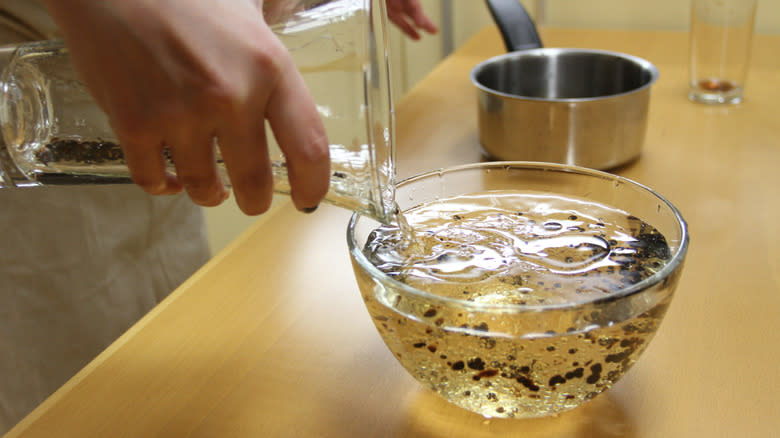
Little jellied orbs, whether sweet or savory, can transform any dinner plate. Spherification might sound scientific, but it's one of the most visually stunning gourmet food cooking techniques to show off your culinary skills. You might think creating these flavorful balls (or caviar pearls, as they're called because they look like fish eggs) is difficult. However, it's relatively straightforward, if you know how, of course. You'll need sodium alginate to mix with whatever liquid you're turning into the spheres. Little drops of the mixture are dripped into a solution of calcium chloride and distilled water to create pearls. They can then be rinsed in water.
If you are using alcohol or cream, you can do reverse spherification and mix the liquid ingredient with calcium chloride and drop this into a sodium alginate solution instead. An additional advantage of this method is that if not served straightaway, the bubbles won't turn solid. Think about all the possibilities of these liquid-filled jelly drops and how amazing the texture and burst of flavor they give each dish is. You could make a salad with balsamic or olive oil spheres, create fruity orbs, and add a burst of bubbles by using Champagne. From canapes to appetizers and main courses, desserts, and cocktails, these little jelly beads make a high-end dining statement.
Foaming
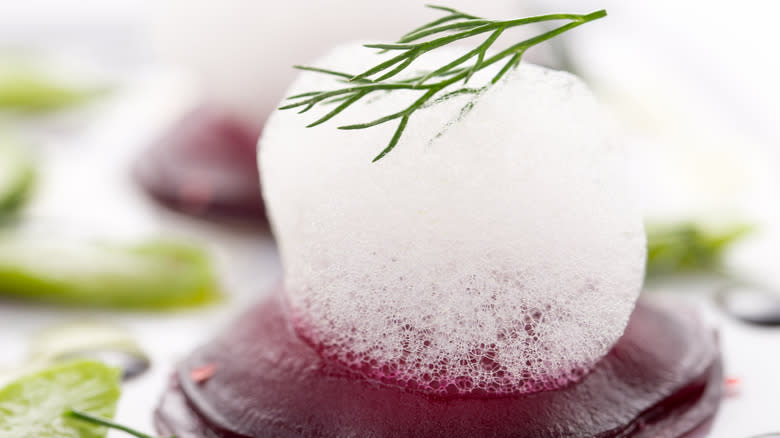
If there's one culinary technique that creates a gourmet look to any dish, it's got to be foaming. And if you want to make the light and airy texture full of umami flavor then a gorgeously upmarket idea is to serve a truffle foam. It's amazing with a mushroom or truffle soup. The simplest way is to whisk whipping cream with truffle oil. However, to make a true foam, blitz soy lecithin with water and truffle oil in a blender. Once the ingredients emulsify, it'll create a bubbly topping.
Foams look frothy but they're not frivolous. They give a dish a sublimely light textural layer and a barely-there puff of flavor. There's endless potential for creating different flavored foams and choosing ingredients that match the rest of the food on the plate. It might help to think about the overall flavor you want to achieve. You can make the foam taste sweet, citrusy, or even cheesy. Another method is to make foam in a whipped cream siphon using cream, gelatin, agar agar, and xanthan gum. You can also use glice to make olive oil foam by heating it in a pan before storing the liquid in a siphon and chilling.
En Papillote

Unfurling brittle parchment paper to reveal a tender, delicately cooked piece of fish inside is a gourmet dining experience. Any interactive plating has all the hallmarks of being a bit fancy and creates anticipation. What makes this culinary technique extra special is how the food inside tastes when it's cooked this way. The French style of baking paper-wrapped dishes in the oven is called en papillote. You can serve the parcels individually or present one larger parcel as a centerpiece. You might want to practice your accent to announce the dish, to impress to the max.
To seal the paper or foil packet, twist the edges together. You don't want the package to be too tightly bound and there are various ways to make your seal. One method is to add the food to one side of a heart-shaped piece of parchment. Fold over the other side and twist inward at the curved area to encase whatever is inside. The food will steam inside and create enough heat to cook quickly. Because of this, you want to choose gourmet foods that don't take ages to cook, such as fine white fish and asparagus. While it's easy to learn, you may need a practice run to master this method to get the timing just right. After all, the food inside is hidden.
Sous Vide
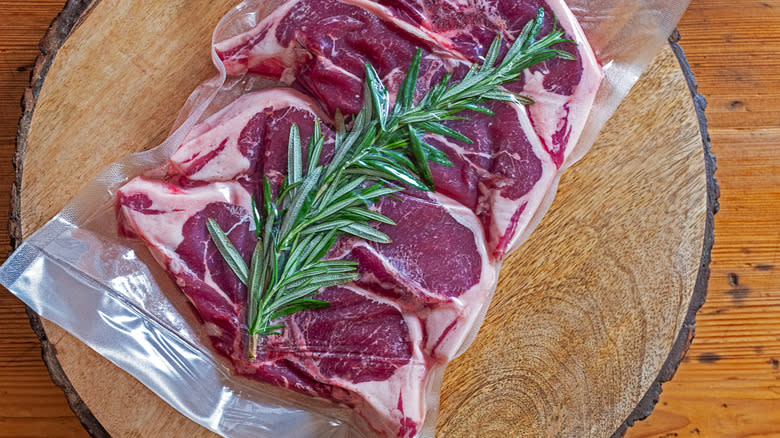
Sous vide is a method of cooking that keeps the flavors locked in and leaves the food tender. Ingredients are added to a bag and cooked slowly in hot water. If you don't have a sous vide machine and can't vacuum-pack lamb cutlets, for example, then you can use a pan of hot water and Ziploc bags. Don't just focus on the entree, either, as sides can be transformed using this technique too. It's easy to elevate a plate of food with sous vide mashed potatoes. Use a water circulator or sous vide wand to set the temperature to 194 degrees Fahrenheit. Cook slices of potato with fresh rosemary, cream, milk, butter, and garlic in a bag with the air expelled. Weight this down with a second bag of coins to make sure it stays submerged.
Another method is to add ingredients to small mason jars, seal them, and cook them in a hot water bath. You can make light and soft sous vide egg bites this way at a controlled temperature of 172 degrees Fahrenheit. While it may sound a little complex, what's fantastic about this technique is that once you've set the heat level and know how long to cook food for, you can leave it to cook to perfection. With meats, the juices don't escape, and gentle cooking creates tenderness in every mouthful. You might want to invest in a sous vide machine and vacuum-packing bags to make this method really stand out. Sear steaks before serving if you want a charred look.
Salt-baking
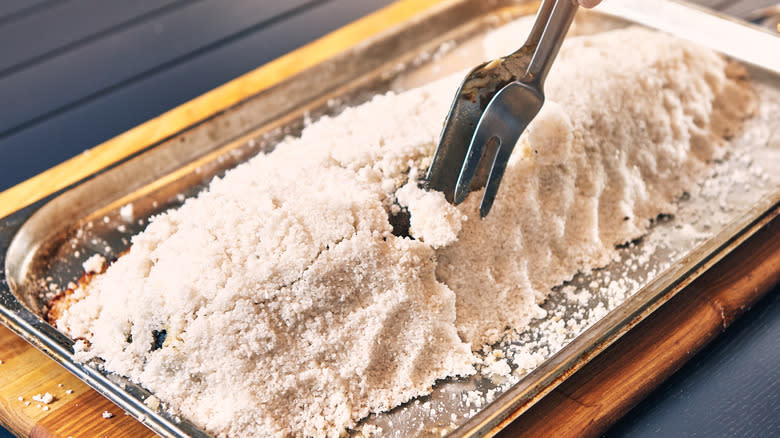
Imagine bringing a tray to a table of unsuspecting dinner guests with a mound of crusted salt, taking out a small hammer, and bashing down on the hard surface. Pulling off the salty crust, a whole baked fish is unearthed. Salt-baking is covering food with a layer of salt mixed with egg whites or water and cooking in the oven. It keeps the juices in and adds seasoning. A whole fish baked in this way comes out succulent and melt-in-the-mouth delicious. You can also cook veggies and other meats like beef in this way.
Keep the salt crust around half an inch thick. Don't dig into the crust during the cooking time, and bake in an oven heated to 425 degrees Fahrenheit so that the outside hardens up quickly. Fish will cook quickly, at around 15 minutes for each pound, with some roasted meats taking double that time. Score the salt around the base before baking so that the crust comes off more easily once it's ready. Don't use your poshest pink Himalayan sea salt for this, as you need a lot of salt and you're going to be throwing the crust away once the food is done. You can add other seasonings to the salt, too.
Gelling

Turning ingredients into different forms is what molecular culinary art is all about. For example, instead of serving homemade ice cream with a lemon mousse, you could add ribbons of lemon gel to create a totally different texture. Gelling or gelification is a technique whereby you heat whatever liquid you want to turn into a gel with agar agar. When the mixture cools, it solidifies. This means that you can create different shapes, from gel sheets to noodles. You can make the gel sweet, savory, or sour by using juices and soups. You can also use gelatin, although this is best suited to ingredients that you don't need to heat too much. Another gelling agent is carrageenan, which works well with dairy liquids.
Experiment with different ingredients, gelling agents, and shapes to create loose gels or firm ones. Think about what visual creativity, taste, and texture you want to achieve. Do you want a sticky gel or maybe a sauce that has a gel-like quality? A key factor to consider is what temperature a gelling agent can be heated to and how that fits with your dish. Gelatin, for example, is best used for cold gel creations, as it melts easily.
En Croûte
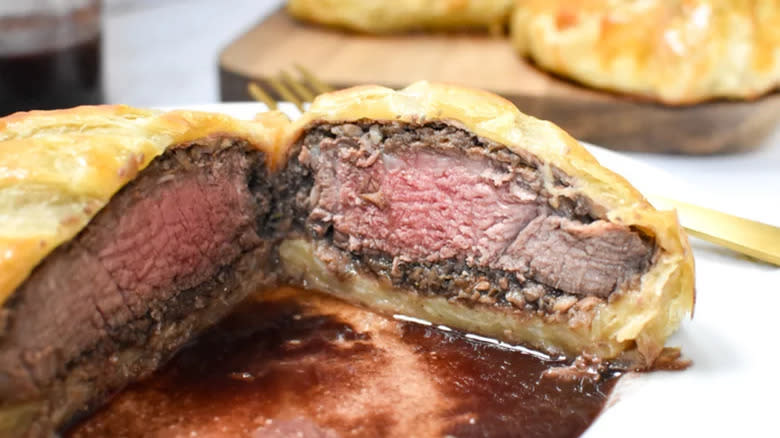
A celebrity-chef-style dish such as Gordon Ramsay's beef Wellington is undoubtedly a luxuriously decadent treat. En croûte is one of the fanciest gourmet food cooking techniques to show off your culinary skills. It may sound high-brow, but what it refers to is pastry-wrapped foods baked in the oven. The golden brown pastry parcel looks fantastic and it tastes even better. Filet mignon topped with herby mushroom duxelles and wrapped in prosciutto and puff pastry is a meal for a special occasion. Make sure you sear the meat first to give it a brown crust. Serve with a red wine sauce at the table.
Not a fan of beef? As long as the food inside cooks at the same rate as the pastry outside, then you're good to go. Another classic is salmon en croûte, with the flakes of fish tasting moreish with the buttery flaky pastry. For an appetizer, you could try pâté en croûte — choose a duck variety for a rich-tasting bite. Use puff pastry or homemade pie pastry with egg yolks.
Confit
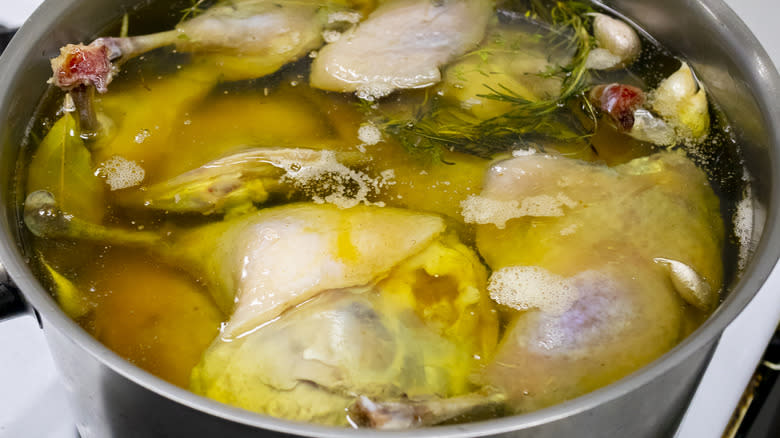
Slow cooker duck confit is a gorgeously gourmet dish. Confit is a culinary technique that involves cooking food in oil at a low temperature, slowly. The temperature is often around 200 degrees Fahrenheit or lower. With meats, confit allows the protein to cook without the juices and moisture burning off as they would with a higher heat setting. The oil preserves the meat as well, meaning that confited meat can last a lot longer than it would if it was cooked in another way.
Add herbs and garlic to the cooking oil for extra flavor. You can also use duck or goose fat. Confit chicken is glorious as is sweet and soft confit garlic and velvety potatoes. Confit in the oven, slow cooker, or on the stove and crisp up the skin on meats like duck legs by putting them under the broiler or in a hot oven for a short time.
Smoking

Smoking meat and fish is undoubtedly a mouthwatering culinary skill. With a wood smoker, part of the process is choosing the right fuel so that pairs well with the food. Think about rubs, seasonings, and marinades before a piece of meat hits the smoker. It's vital that the meat rests for a considerable amount of time once it's been cooked. If you don't own a purpose-built smoker, cover burning wood chips in a suitable container with foil and poke holes in the top. Add a rack and the food you want to smoke. Cover with a lid and you've got your own homemade smoker.
You can also make a smoker with a tin by adding a rack inside, chips in the bottom, and holes in the lid. Place this on hot coals. Obviously, this is for outdoor cooking only. Inside, what about serving food in a glass-domed cloche filled with smoke to dinner party guests? Use a culinary smoking gun to create this cold-smoking effect to infuse foods such as cheese, and serve in a well-ventilated space.
Creating Flavored Powders
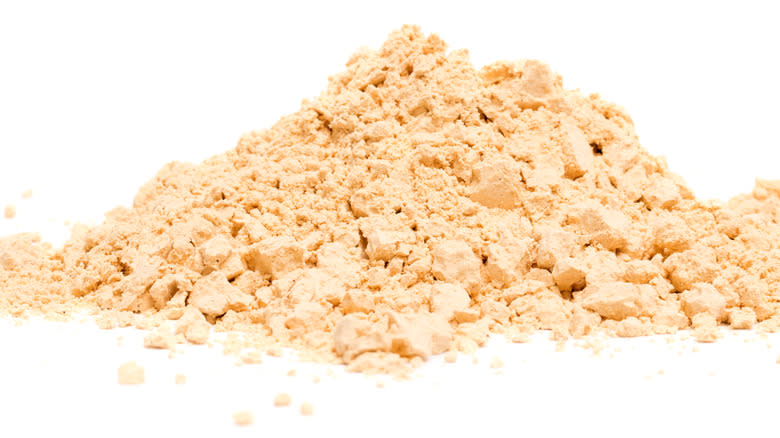
You can elevate dishes by playing with texture through a variety of gourmet food cooking techniques to show off your culinary skills. A wonderful way to do this is by turning foods into powders and sprinkling these on dishes. It's a favorite method of many a high-class chef and a great molecular kitchen process to know about. While you can deep-dive into the science, all you really need to know is that by mixing a liquid with maltodextrin you turn it into a powder. Try this with olive oil for a novel way to incorporate this into a Mediterranean dish. Add a little spice or salt as the process sweetens the oil a little.
There are so many ways you can experiment. Imagine adding peanut butter powder or chocolatey Nutella powder to a dessert. What about a flavorful powdered cheesecake filling? Or you could make powdered bacon fat as a garnish for a savory dish.
Kitchen Blowtorching

A gorgeous gourmet dessert that's rich and creamy is crème brûlée. Aside from the wonderfully sweet taste, it's a great excuse to use a kitchen blowtorch. This is one of those culinary gadgets that's so satisfying to use that you'll be looking for dishes to blast it with. Once individual brûlées are set, sprinkle on the sugar and fire up the flames to caramelize the top. Let the melted sugary top harden. There's nothing as grand as a spoon cracking through to the soft decadence underneath.
Besides creating the crunchy top of crème brûlée, you can use a torch to sear cooked shrimp or oysters or add a little char to sous vide meat such as succulent pork belly. This is the perfect kitchen tool for browning baked Alaska, melting cheese into little bites, or softening the top of a wheel of brie so that you can dip into it.
Read the original article on Mashed.

